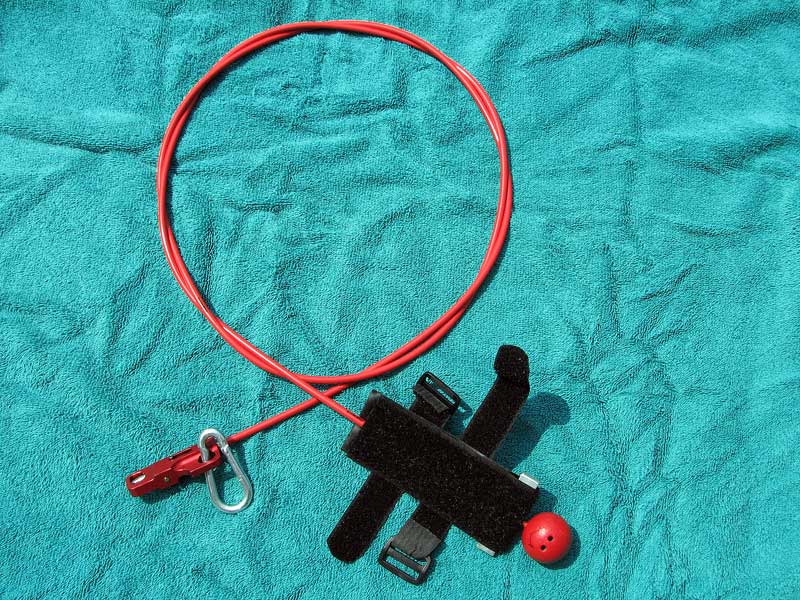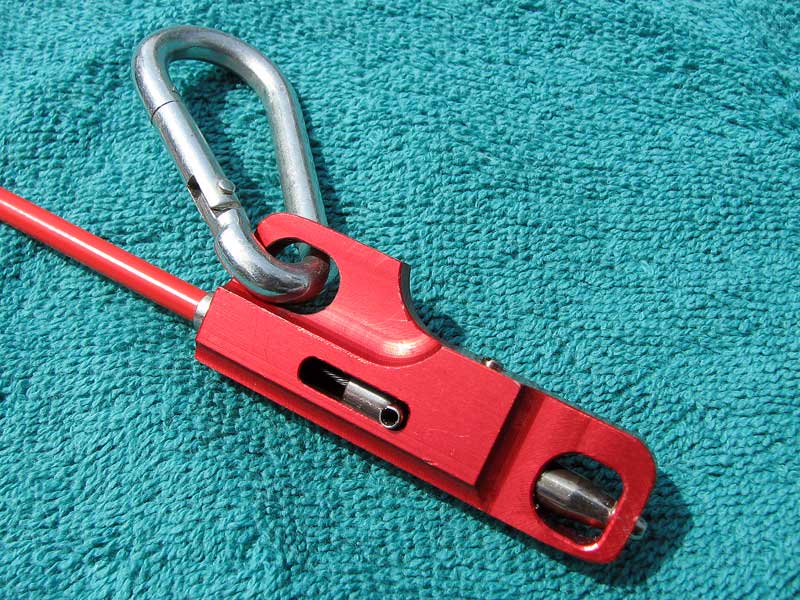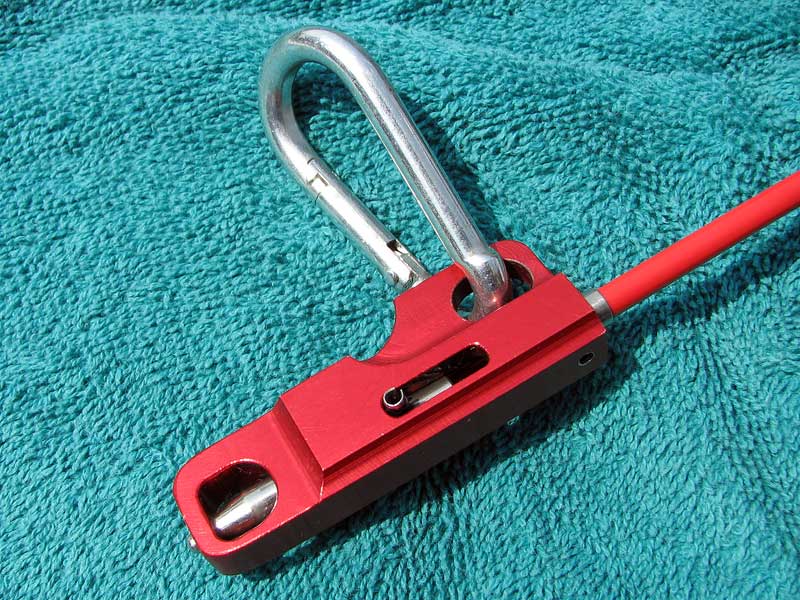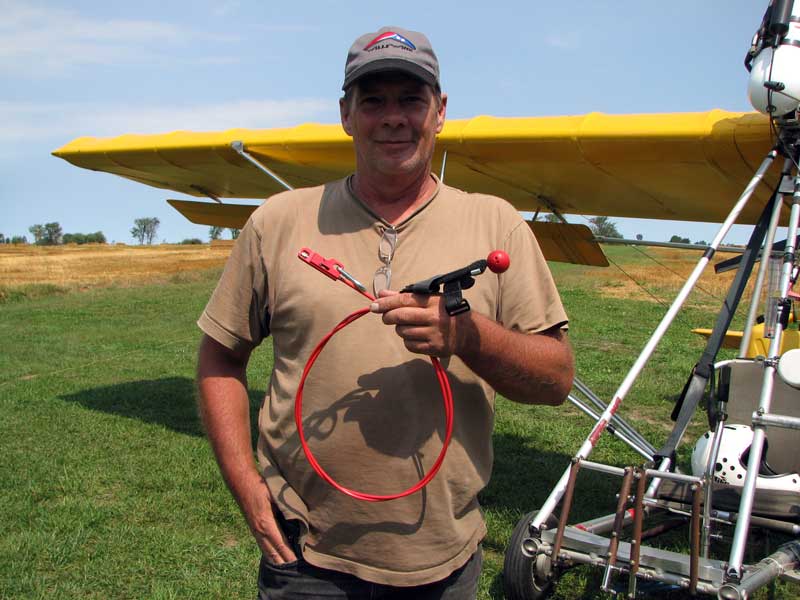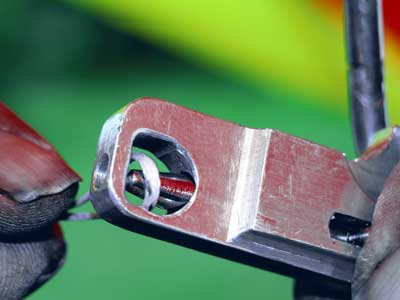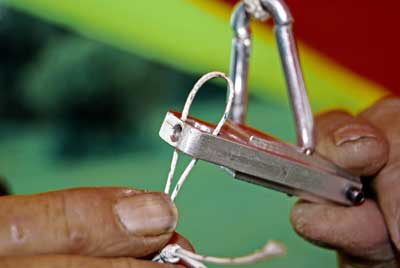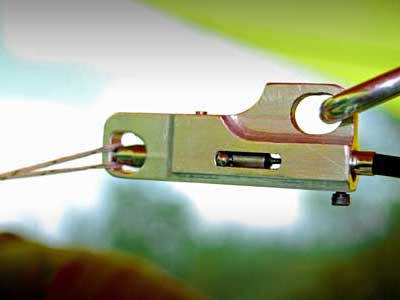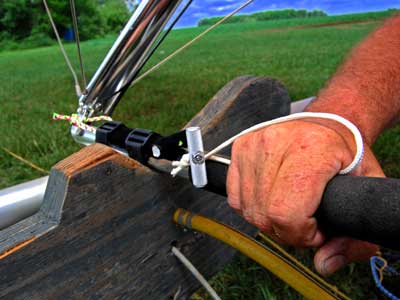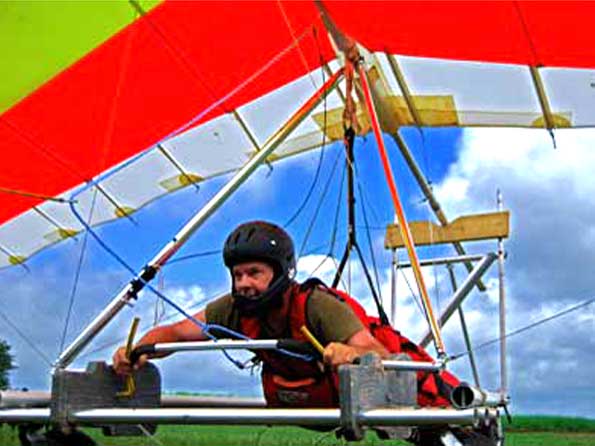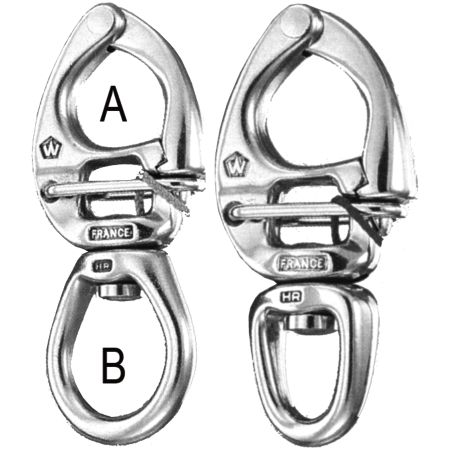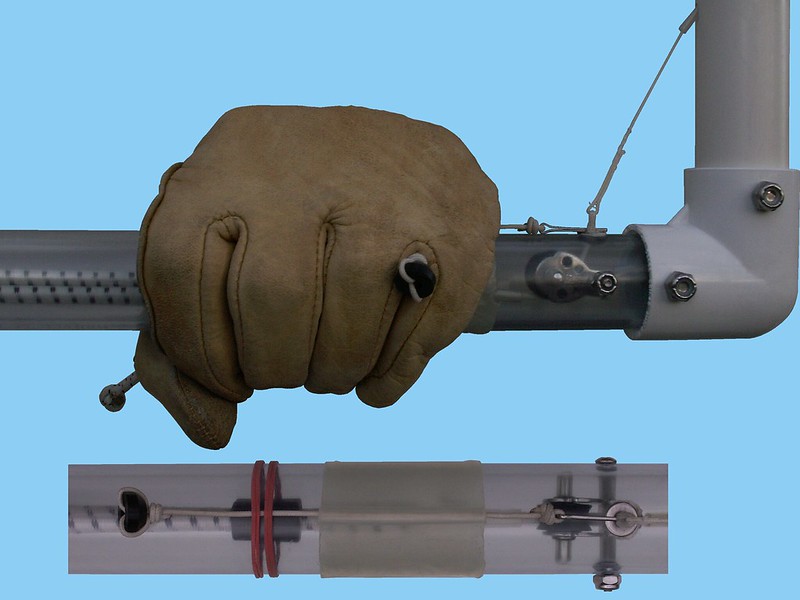http://www.skydogsports.com/release/
New Aerotow Release
by
Steve Younger
Steve has been a tug pilot for over twenty years now and a hang glider pilot for thirty five years and saw the need for the perfect release for aerotowing and other forms of towing hang gliders and has designed the SteevRelease. Below are close up photos of the new SteevRelease.
SteevRelease Complete
SteevRelease End Close-Up - Notice the Tapered Pin For Fast Action
SteevRelease Handle
SteevRelease End
Steve Younger
The SteevRelease was designed to be an integral part of a three point Aero tow bridle and was not designed to be used in a two point (Pro Tow) or as a single point tow release.
The mounting and location of this release should be determined by your glider manufacturer or there representative. The SteevRelease is designed to be easily attached to or removed from your glider for ease of storage and to prevent accidental damage during transport.
The body of your SteevRelease is simply clipped to the loop of line anchored and located at the factory recommended location on the keel of your glider.
Release End --- Handle
The cable of your SteevRelease is routed back along the keel and down the down tubes anchoring to the down tubes using the supplied Velcro straps.
It is important at this point to insure that your harness straps are not going to interfere with the cable or its operation. It may be necessary to route the cable around the outside of the control frame.
The activation handle is mounted to the base tube using the supplied velcro straps and then anchored by the tether to the corner bracket of your control frame.
Your SteevRelease should be clean and dry at all times and should be inspected for signs of wear or damage before each use.
S --- P
When inserting the weak link insure that the link is properly sitting on the pin and that the pin is fully extended.
Finally make sure that the release and cables are unobstructed in any position possible during tow and that there is no tension on the activation cable at any time.
S
The SteeveRelease should offer you many years of problem free towing. However due to the infinite number of glider configurations possible installations and routings SteevRelease, any employees or representative can not be held responsible for a poorly installed or maintained system.
PLEASE SEEK THE ADVISE OF A PROFESSIONAL WHEN INSTALLING ANY NEW TOW SYSTEM
Questions concerning the SteeveRelease - E-mail Steve Younger at - catstevan@yahoo.ca
Which is the least bit relevant to the issue of designing an aerotow release (or any other item of glider hardware) how? How does that make you as qualified as a sharp junior high science fair contestant who's only seen pictures of hang gliders? Matt Taber, Steve Wendt, Bo Hagewood, Tracy Tillman... Need I say more?Steve has been a tug pilot for over twenty years now and a hang glider pilot for thirty five years...
Sorry, but "the perfect release for aerotowing" is NEVER gonna involve seven feet of cable velcroed onto a downtube....and saw the need for the perfect release for aerotowing...
If ya wanna try to get ANYTHING right - from procedures to takeoff to releases to weak links to landings - ya gotta look to sailplaning. Sailplane releases are not some afterthought duct-taped to the outside of the fuselage - they're designed and built IN.
If you wanna get a clue from someone who has the EXACT proper vision for the perfect hang glider aerotow release...
http://groups.yahoo.com/group/skysailingtowing/message/4411
Keel Attachment
If you wanna see photos of a system that fulfilled that vision years before John expressed it...John Moody - 2004/12/16 23:07:36 UTC
Conroe, Texas
What is not normal is to see a factory-made glider that has a built in nose attachment or keel attachment or even the keel release built-in, faired and clean - like a VG system is.
So why does Mr. Reynoldson have to ask where to attach his tow line? Atos has to know that their gliders are being towed every day. Why does each pilot have to figure it out, one at a time. Why don't the manufacturers sell a TOWING version of their gliders and avoid someone getting it wrong?
http://www.flickr.com/photos/aerotowrelease/sets/72057594141352219/
I'm not seeing any suggestions or recommendations for using the SteevRelease in other forms of towing hang gliders. I'm seeing statements which indicate quite the opposite....and other forms of towing hang gliders...
Implying that this IS "the perfect release for aerotowing". Not by any stretch of the imagination....and has designed the SteevRelease.
How fast?SteevRelease End Close-Up - Notice the Tapered Pin For Fast Action
Granted, the Wichard spinnaker shackle is a lousy piece of hardware for this application. The gate tapers THE WRONG WAY...
http://www.flickr.com/photos/aerotowrelease/8318781297/

...and it has an unfortunate notch...
http://www.flickr.com/photos/aerotowrelease/8318846765/
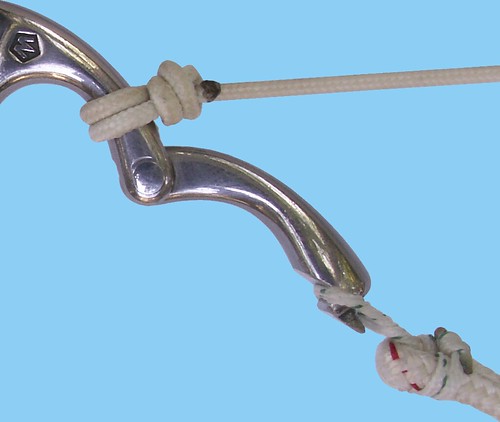
...but if you don't jump through too many hoops to get the thing to jam - the way Robin did - it's not a totally unreasonable way to slap things together.
So how much FASTER is the SteevRelease?
You're designing this mechanism around a HEAVILY SIDE LOADED PIN connected to a notoriously problematic cable/housing assembly terminating in a loop that the pilot is supposed to be able to pull with benefit of ZERO mechanical advantage. Assuming the internal workings of the mechanism are something close to frictionless you MAY still be in reasonable shape - but I doubt it.SteevRelease End
There is NOTHING comparable I know of in any aviation, skydiving, or sailboat hardware - all of which is based upon simple machine principles - lever, pulley, inclined plane.
I fly at 320 pounds and use a weak link which limits me to about 473 pounds of towline tension - a bit under one and a half Gs. It'll load that release to 272 pounds.
Forget twice weak link. How hard have I gotta pull on that loop to blow the release when it's feeling 272 pounds?The United States Hang Gliding and Paragliding Association, Inc.
Standard Operating Procedure
12. Rating System
02. Pilot Proficiency System
10. Hang Gliding Aerotow Ratings
-B. Aero Vehicle Requirements
06. A release must be placed at the hang glider end of the tow line within easy reach of the pilot. This release shall be operational with zero tow line force up to twice the rated breaking strength of the weak link.
While we're looking at the Dragonfly...Steve Younger
1. What are you using for weak link(s) on the on the front end and where is (are) it (they) installed?The United States Hang Gliding and Paragliding Association, Inc.
Standard Operating Procedure
12. Rating System
02. Pilot Proficiency System
10. Hang Gliding Aerotow Ratings
-B. Aero Vehicle Requirements
05. A weak link must be placed at both ends of the tow line. The weak link at the glider end must have a breaking strength that will break before the towline tension exceeds twice the weight of the hang glider pilot and glider combination. The weak link at the tow plane end of the towline should break with a towline tension approximately 100 lbs. greater than the glider end.
2. If I fly at one and a half Gs you're gonna keep the rope, right?
1. There's no such thing as a three point aerotow bridle. There's a two point bridle which splits the load between the pilot and glider and a one point bridle - both ends of which go to the pilot - which connects to either the tow ring or the bottom of the two point bridle.The SteevRelease was designed to be an integral part of a three point Aero tow bridle and was not designed to be used in a two point (Pro Tow) or as a single point tow release.
2. There's no such thing as "Pro Tow". There's two point and safety compromised towing.
Their. Or, if you wanna go all the way and do it right - its (singular).The mounting and location of this release should be determined by your glider manufacturer or there...
If it were done right the glider would come from the manufacturer with the location and mounting already taken care of and you wouldn't need to be dealing with some idiot representative....representative.
Notice that sailplane release and hang glider VG systems don't need to be easily attached to or removed from the glider for ease of storage and to prevent accidental damage during transport.The SteevRelease is designed to be easily attached to or removed from your glider for ease of storage and to prevent accidental damage during transport.
Wild guess... 130 pound Greenspot? Is there some skinny fourteen-year-old kid standing in line? Do you also tow adults?Release End
Instead of inside the tubing and out of the airflow like they do in REAL aviation.The cable of your SteevRelease is routed back along the keel and down the down tubes anchoring to the down tubes using the supplied Velcro straps.
Which wouldn't be an issue if the job were done right the way it is in REAL aviation.It is important at this point to insure that your harness straps are not going to interfere with the cable or its operation.
Which wouldn't be an issue if the job were done right the way it is in REAL aviation.It may be necessary to route the cable around the outside of the control frame.
You haven't shown us before or previously mentioned the tether.The activation handle is mounted to the base tube using the supplied velcro straps and then anchored by the tether to the corner bracket of your control frame.
Which wouldn't be an issue if the job were done right the way it is in REAL aviation.Finally make sure that the release and cables are unobstructed in any position possible during tow and that there is no tension on the activation cable at any time.
I'm looking at the last couple of photos and I'm not seeing any wheels, Steve. Is that 'cause the SteevRelease makes it difficult, problematic, or impossible to install a good - or not so good - pair of wheels on the basetube?
I can think of a couple of good ways to break your freakin' neck towing hang gliders. One of them is to put the release lever on the downtube and another is to take the wheels off the basetube. And if your release configuration is encouraging or forcing people to take the wheels off - which it is - it's hard to make a case that you're making towing better and safer.
Those photos themselves are sending a dangerous message to people who really suck at threat assessment anyway.
(I'm also seeing those dolly brackets spaced a lot closer together that they should be.)
Especially since there are no wheels... Is it a great idea to have your hand inside a loop?
I see a little red ball on the end of the lanyard in the earlier photos - which looks like a MUCH better idea - but you're not saying anything about it and we're getting conflicting information.Tom Bushell - 1985/10
Nova Scotia
We recently had an unfortunate towing accident in which a student pilot dislocated her elbow. On her third tow flight she neglected to flare on landing. The wheels dug into rough ground and she swung through. The wrist release line pulled tight and caused the dislocation.
ALL two point release systems require secondary releases at the bottom 'cause one can never be sure that the bridle's gonna clear the tow ring. There's a limited value in putting effort into designing a primary release system when your secondary is crap. And from what I can see of that secondary configuration in that low resolution last photo - it's crap.
If the pilot's life is dependent upon blowing tow with both hands on the basetube - which is the foundation of your primary design - he's one bridle wrap away from being dead anyway.
And if that secondary assembly is anything like damn near everything else I've ever seen at any idiot flight park there's no guarantee that the pilot's gonna even be able to get off AT ALL without the luxury of a hook knife and lotsa time.
Let's say in that photo you've got a loop of 130 pound Greenspot on your right shoulder and a Bailey release - with no weak link on your left. Your primary bridle wraps, your secondary weak link blows, your secondary bridle doesn't make in through the eye of the primary, and all the tow tension is going to the Bailey. Assuming you're still alive at this point, are you gonna be able to let go of the basetube and pull the barrel back while the lockout is accelerating? Have you ever tested the Bailey under load?
1. There's an extra "e" in SteevRelease this time.The SteeveRelease should offer you many years of problem free towing.
2. Not in anybody's wildest dreams. There never has been and never will be any such thing as problem free hang glider towing.
A hang glider has mediocre control authority to begin with and when you hook it up to something it becomes dangerously roll unstable. You can be the best pilot with the fastest reflexes in the world using the best equipment and best tow driver and be on your ear before you can BLINK.
Whenever you're on the back end of a rope your life can become instantly dependent upon what the guy - and the equipment - on the other end does - or doesn't - do. Front end weak links blow, towlines fail, and drivers dump tension. All of those things HAVE killed glider pilots. Engines and propeller shaft sleeve bearings seize and propellers spin off. Those sorts of things CAN kill glider pilots just as effectively.
I watched a fuel tank go through a trike propeller on the day of my first aerotow. Very few drivers know what they're doing and some have problems. The guy who lost that fuel tank - who DID know what he was doing - later died of a heart attack while doing loops in a trike. Two people I've towed with have committed suicide - one, the designer of a successful tug - after first blowing away the girlfriend.
So let's make the equipment and training as good as possible and put streamers down the runway. But let's not ever expect trouble free towing - especially during that first couple of hundred feet.
1. That sentence needs some work. Maybe an "and" between "configurations" and "possible".However due to the infinite number of glider configurations possible installations and routings SteevRelease, any employees or representative can not be held responsible for a poorly installed or maintained system.
2. Infinite? You're talking about three tubes making up a control frame and another serving as the keel. This ain't rocket science.
Right. You can trust any of these people as long as they run flight parks and/or fly tugs. No way they'd ever get anything wrong enough to kill anyone - more than once a year or so anyway. ("ADVICE" by the way.)PLEASE SEEK THE ADVISE OF A PROFESSIONAL WHEN INSTALLING ANY NEW TOW SYSTEM
Summary...
There is no indication whatsoever that this release has been load tested even to the limit of the pathetic loop of 130 Greenspot that idiots the world over believe to put all solo gliders at precisely the 1.0 Gs that idiots the world over believe to be the ideal rating for an aerotow weak link.
Just looking at it I would be astounded if it had a fraction of the capacity of the panic snap based release I purchased from Bill Moyes twenty years ago for thirty-five bucks and I would strongly advise that it not be used until there's been published some performance data which proves my assessment wrong.
